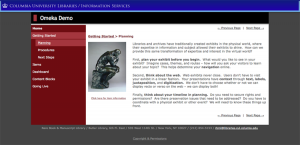This winter and spring, LDPD supported five projects built using Omeka, our online exhibition platform. These online exhibitions range from the very current Love In Action project, which actively gathers supporting documents and photos from Union Theological Seminary’s present-day activism, to early modern literature from the Elizabethan and Jacobean period. The exhibitions accompany a conference, in the case of Early Modern Futures; a civil rights and protest movement in the case of Love in Action; and an important publication by a prominent Columbia University faculty member, in the case of the Sydney Howard Gay exhibition. LDPD explored new technologies including a self-deposit feature which we implemented for the Love In Action exhibition, and has supported varying requirements and needs to help make each of these exhibitions possible.
LDPD facilitates the creation and presentation of our online exhibitions using Omeka, an open-source, exhibit-focused content management system. We help curators navigate the process and take the necessary steps to move from the idea for an exhibition to curating, creating, and publishing that exhibition. Melanie Wacker and Robbie Blitz begin by scheduling a metadata consultation with the curator. After the curator has filled out the metadata spreadsheet, we review and send any corrections; coordinate the imaging of the items with the Digital Imaging Lab; bulk upload the digital assets and completed metadata into Omeka; provision the curator’s Omeka account; and provide training. Exhibitions are structured and include a narrative about the items that are included and the relationships between those items. An introduction to curating online exhibitions was created by LDPD and offers information about how to conceptualize and actualize one’s curatorial ideas. (The Online Exhibition Planning Form and checklist are available on the wiki at: https://wiki.cul.columbia.edu/display/digprog/Procedures+for+New+Digitization+Projects .)
LDPD began using Omeka to support the Libraries’ Online Exhibitions in 2009. The system is flexible and has been easy for contributors to use. Supporting both the system and the creation of the exhibitions has been straightforward and easy to streamline. We developed templates that allow users to customize the colors of their exhibition, and the consistent Columbia Libraries’ look and feel clearly indicates to users that they are in a trusted Columbia University online environment, while providing links to other online Libraries services. There is an active community of Omeka users at other institutions that we can work with to customize the software when needed, ensuring that we don’t reinvent a plugin or recode a customization when someone else has already done that work.
Our exhibitions are sometimes created and published in conjunction with on-site exhibitions at the Libraries, and because we no longer publish printed catalogs for exhibitions, our Omeka online exhibitions often function as such. They offer the additional benefits of being freely and widely available, and of providing ongoing access to the items once the physical exhibition has ended. They are a great way to begin to explore some of our treasured collections and to be introduced to the riches that we have available to researchers in our physical collections. Over time all digital content created for our Omeka exhibitions that we own will be added to Fedora. Depending on copyright restrictions, the content will also be made available through our Digital Library Collections portal and within the Digital Public Library of America.
